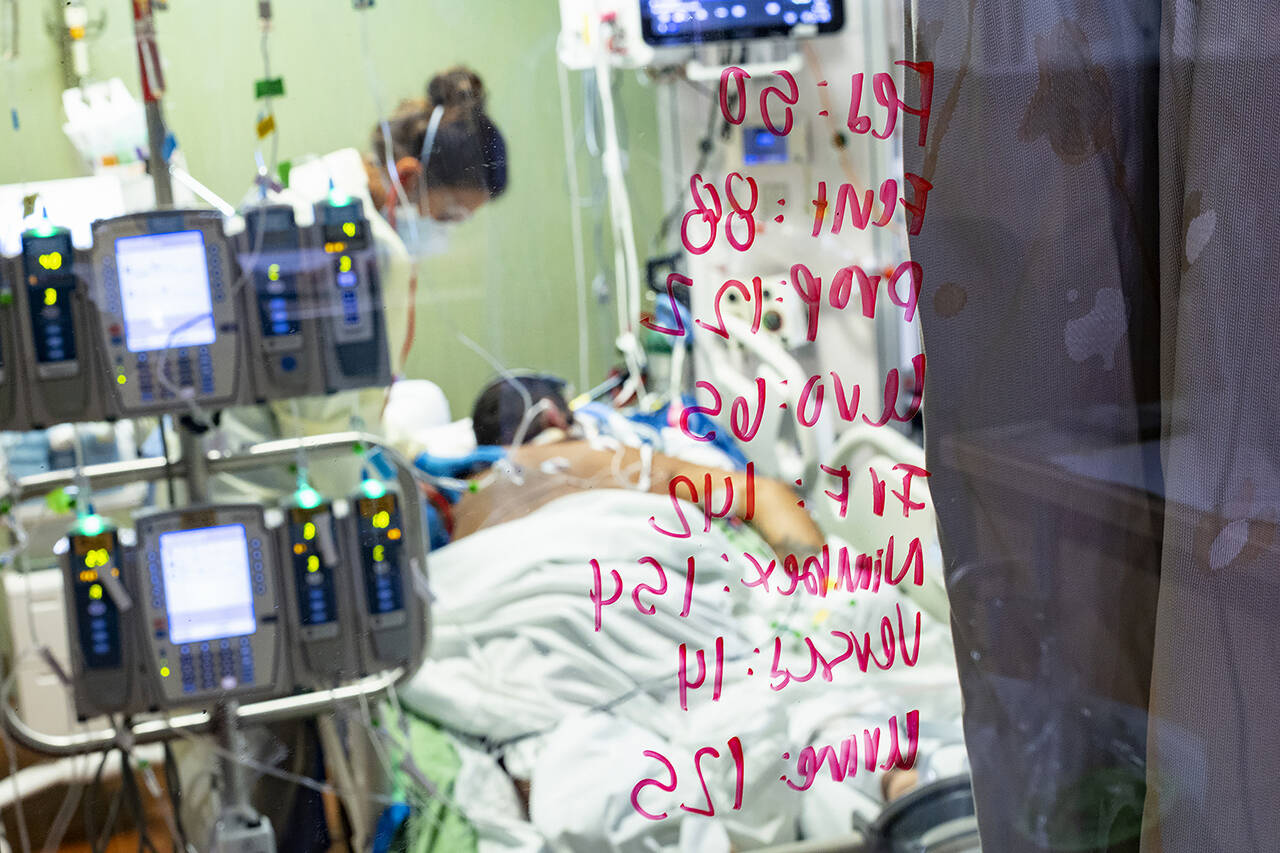By Rebecca Boone / Associated Press
BOISE, Idaho — Amid the Idaho coronavirus surge that prompted officials to authorize hospitals to ration health care, Army soldiers sent to one hospital have traded their fatigues for personal protective equipment to help treat a flood of infected patients.
The conference center at Kootenai Health hospital in the city Coeur d’Alene has been converted into a field hospital of sorts — with some of its classrooms filled with hospital beds where patients receive oxygen or get monoclonal antibody treatment, hospital officials said.
At the nearby main hospital building in the city of about 50,000, some emergency room patients receive care in a converted lobby and others get it in hallways. Urgent surgeries have been put on hold and some patients in critical condition are facing long waits for intensive care beds.
The overwhelmed hospital is at the epicenter of a coronavirus crisis for the northern part of the state — and where state officials this week authorized “crisis standards of care” status.
That allowed Kootenai Health, where an entire floor has been turned into a makeshift COVID-19 unit, and other hospitals in the region to ration health care during the surge.
Public health officials are warning the health care rationing could soon spread statewide, forcing already traumatized doctors and nurses to make gut-wrenching decisions about who will get life-saving care.
Newly confirmed coronavirus infection cases in Idaho are surging and the state is now averaging more than 950 new cases every day, according Johns Hopkins University — an increase of more than 41% over the past two weeks.
Idaho is also last among U.S. states with only about 45% of residents having received at least one dose of COVID-19 vaccine, according to the Centers for Disease Control. Just under 40% of residents are fully vaccinated, making Idaho 48th the nation compared to other states and Washington, D.C.
“For the rest of the state, we remain dangerously close to crisis standards of care,” Idaho Department of Health and Welfare Director Dave Jeppesen warned Tuesday, when there were just nine available intensive care unit beds in the entire state.
The crush of patients has forced Kootenai Health into “doing things that were not normal — way outside of normal — at times,” said hospital chief of staff Dr. Robert Scoggins.
“Almost every day at this point we are having cardiac arrest from patients when their oxygen levels dip too low and we can’t supply them with enough oxygen,” he said.
While many of northern Idaho’s smaller, rural hospitals have not been forced to ration health care, they frequently have no place to send their critically ill patients who would normally be transferred to Kootenai Health.
Hospitals in neighboring Washington state would normally help with the overflow, but they are also full of patients, Jeppesen said.
Peter Mundt, the spokesman for Gritman Medical Center in the Idaho city of Moscow said the institution is struggling to find hospital destinations to transfer patients with serious heart problems and other conditions unrelated to COVID-19.
“Our ability to accommodate non-COVID patients are very strained at this point,” Mundt said. “Even though we’re all different hospitals, we normally work together as collaborative colleagues and peers. We need it to work as a giant system and that system is just under severe strain right now.”
In the city of Lewiston, St. Joseph Regional Medical Center is also operating “at the very edge of our capacity,” spokeswoman Sam Skinner said.
“Our current situation is worse than it’s ever been,” Skinner said. “As we continue to see the COVID-19 surge in our community, the impact on one hospital can quickly have this rippling effect. Our low community vaccination rates are putting an incredible burden on our community.”
The Idaho Department of Health and Welfare moved northern and north-central Idaho into the crisis designation Monday evening, giving hospitals a legal and ethical template to use while rationing care.
The designation will remain in effect until there are enough resources — including staffing, hospital beds and equipment or a drop in the number of patients — to provide normal levels of treatment to all patients.
Under the guidelines, patients are given priority scores based on a number of factors that impact their likelihood of surviving a health crisis.
Those deemed in most in need of care and most likely to benefit from it are put on priority lists for scarce resources like ICU beds.
Others in dire need but with lower chances of surviving will be given “comfort care” to help keep them pain-free whether they succumb to their illnesses or recover.
Other patients with serious but not life-threatening medical problems will face delays in receiving care until resources are available.
Jeppesen stressed Tuesday that vaccines are the best way to reduce the demand on hospitals. Data from the U.S. Centers for Disease Control and Prevention shows that full vaccination with any of the currently available coronavirus vaccines dramatically reduces the risk of requiring hospitalization for a coronavirus infection.
State health officials have also asked people should not go to emergency rooms for asymptomatic coronavirus tests or other matters that can be handled in doctor’s offices, but said no one should hold off emergency room visits for potentially serious conditions. They warned people people to be prepared to wait for care.
Idaho’s hospitals have struggled to fill empty nursing, housekeeping and other health care positions, in part because some staffers have left because they are burned out by the strain of the pandemic and because others have been quarantined because they were exposed to COVID-19.
Late last month, Little called in 220 medical workers available through federal programs and mobilized 150 Idaho National Guard soldiers to help hospitals cope with the surge.
Talk to us
> Give us your news tips.
> Send us a letter to the editor.
> More Herald contact information.

























